He was an old trustee of the Soon Thian Keing (Temple) who together with his wife is buried at Bukit Brown. Through his personal memories, Ho Siew Tien (1864-1960) helped shed light on the temple’s history.
This story by Ang Yik Han begins with the origins of one of the oldest temples in Singapore.
***************************************************************************************
In the 1980s, a debate took place in the local newspapers over the age of an old Chinese temple dedicated to the earth deity Tua Pek Kong in Malabar Street. Historians argued over an ambiguous phrase in one of the temple’s old stelae, which stated that the temple, the Soon Thian Keing (順天宮), was established during the years of the reigns of Jiaqing and Daoguang (“嘉道之際”). As the Jiaqing Emperor ruled from 1796 to 1820 and Daoguang from 1821 to 1850, proponents of an earlier dating for the temple argued that its establishment may have predated the founding of Singapore in 1819. However, there was no direct evidence to support this claim. No artefacts survived from the temple’s earliest days and the stele in question was erected only in 1902 when the temple was reconstructed.

Part of the 1902 stele still preserved in the Soon Thian Keing today. It shows the main temple sponsors and major contributors to the temple’s building fund (photo Yik Han)
One the earliest known accounts of the Soon Thian Keing before its reconstruction was an interview given by one of its trustees, Ho Siew Tian (何秀填), in 1949. He recalled that when he first arrived in Singapore in 1882 at the age of 18, the temple was only a small shrine located next to a tree which housed the Tua Pek Kong statue. The shrine was refurbished by two merchants in 1888. It was only in 1902 (28th year of Guangxu’s reign) that some merchants based in the Sio Po area (the colloquial Chinese term for the part of town north of the Singapore River) came together to construct a proper building for the temple.
Other than getting a new building, the turn of the 20th century was significant for the temple for another reason. Some Hokkien merchants started a school in 1903 and then turned to the temple committee for funding to sustain the school. Thus began the decades long association between the temple and the Chung Cheng School (崇正学校) [not to be confused with Chung Cheng High (中正學校) which was managed by the Hokkien Association].
Every year, the temple provided for the school’s upkeep from the money paid by the resident monk who was contracted to run the temple. In 1916, a school for girls, the Chong Pun Girls School (崇本女校) was started and likewise funded by the temple. Committee members of the Soon Thian Keing sat on the boards of both schools. Prominent alumni members of the Chung Cheng School over the years included Lee Kong Chian and President Ong Teng Cheong.
As the number of students increased, the need for new premises for both schools was keenly felt. In 1938, the construction of a new school building at Aliwal Street was completed. This housed both the Chung Cheng School as well as the Chong Pun Girls School under one roof. It was recorded that Ho Siew Tian was a prime driver in the construction of the new school building along with the then temple chairman. A trustee of the Soon Thian Keing since 1933, he was concurrently the treasurer of the temple and the two schools, a position he held till after the war.
Hailed as one of the most modern Chinese school buildings of its day, the building has been preserved and is today the Aliwal Arts Centre.
As Aw Boon Haw donated substantial funds towards the building’s construction, the school hall was named after his company, Haw Par.
Old photos dating from 1950 which showed girls of Chong Pun exercising in the school field, today a carpark. Sultan Mosque can be seen in the background.
Ho Siew Tian ran a thriving hardware and building materials business under the chop Ho Hock Ann (何福安) at Beach Road. He also owned a number of twakows for transporting goods. As his wealth grew, he made substantial investments in properties. In 1948, he incorporated his firm as a limited company and handed over its running to his sons, who subsequently expanded the business to firearms.
It was urban redevelopment which spelled the end for the temple and the schools. In 1980s, the temple was acquired by the government for building the MRT. It moved successively to various temporary sites before its present building at Lorong 29 Geylang was completed. With the resettlement of the urban residents in the area, dwindling student enrolment led to the closure of Chung Cheng School in the 1980s as well. Its name was transferred to a primary school in Tampines.
Soon Thian Keing today in Lor 29 Geylang (photo Yik Han)
Ho Siew Tian is buried at Hill 4 together with his wife who died 12 years before him. According to obituaries in the Straits Times and the Singapore Free Press, he was one of the oldest men in Singapore at the point of his death at the age of 96. He was survived by 5 sons (2 other sons died before him), 3 daughters, 2 sons-in-law, 7 daughters-in-law, 81 grandchildren, 8 grand sons-in-law, 4 granddaughters-in-law and 37 great grandchildren.
It has been a long time coming, 3 years in gestation but Darren Koh – a pioneer member and solid contributor of the FB group community Singapore Heritage Bukit Brown Cemetery – has finally joined the ranks of Brownies who conduct guided walks. All Things Bukit Brown (atBB) caught up with Darren – whose day job is lecturing on taxation in a tertiary institution – and asks why now and what took him so long?
atBB : You have been following and contributing to the community online for a number of years, why have you now decided to join the ranks of brownies who conduct guided walks?
Darren I blame Chew Keng Kiat! Some time ago, we were chatting and I asked him if he recalled when the “brownies” came into being. He dated the Brownies back to one evening in Sago Lane – in fact the funeral of Raymond Goh’s father. Keng Kiat mentioned there was this group of people at a table at the end of the tentage. I reminded him I was there too – I was sitting with Mil, Su-Min and Vicky at one end. Keng Kiat mentioned that everyone at the table agreed that the Goh brothers could not possibly hunt down tombs and spread the knowledge of Bukit Brown all on their own. Plans for the 8 lane highway had just been announced and time was short. That was about when everyone at the table agreed to take on the guiding so that Raymond and Charles could focus on the tomb hunting. “Teach us. Let us do this for you.” And so – to the memory of Keng Kiat at least, the Brownies were born. Unfortunately for me, my asking when the Brownies was born also pencilled in his memory that I had not guided any walks. Since my conversation with him about that evening, he has often taken the opportunity to ask when I would actually guide. Even as recently as this year’s Chinese New Year dinner, Keng Kiat nudged me again and said “Look around you – everyone at that table so many years ago has gone on to guide. You are the only one who hasn’t. When are you going to do so?”
Truth of the matter was that it was always going to be a matter of time. I was in the midst of getting a new programme running at the university, and that was just soaking up my time. I did not have many people helping me teach then, and I was teaching many of the courses myself. And the courses took place at the weekends. So I really could not go out to the hills as often as everyone did. As you point out, I have been keeping in touch with the Brownies and following the discoveries, the developments, the joys and the lows. But always once removed. I must say, the Brownies were kind enough to include me in many of the offsite events (read – dinner!, etc) and it was at one event when one of our guests asked if I was a Brownie that I sort of blurted out “Not really – I have helped out in some walks but have not guided one myself. I do not think I can wear the title until I have done that.” And that I think was when Catherine jumped in an said, “He’s an Associate Brownie!” So yay! I had a place!
Now that the programme at the university is more settled, I can breathe again, and I was looking to get out of the air-conditioned world, and maybe get more exercise, and do something I like…. I realised why not just guide walks. It ticks all the right boxes – it’s in the midst of nature, it’s out of the artificial world of the office, I will walk a lot, and I will get to do what I like – tell stories. A perfect fit. And so, after a couple of weekends of doing my homework (i.e. walking the hills, trying to find the tombs, getting lost amongst the stones), I started guiding.
atBB Share what has been your experience like so far after 3 guided walks.
Darren It’s been great! Each one has been different: the routing, the tombs we visited and therefore the story that was told was different. And in the last walk, I even had to abort a visit to two tombs and think of rapid replacements as the tombs I had wanted to visit were inaccessible.
It is usually good to have people ask questions – although sometimes that is scary as you never know which angle they will come from. But the good thing about being a volunteer guide is that I can say “I don’t know – will have to get back to you on that.” A bit more difficult to say that in my normal classes!
The one thing I am reminded of, is a piece of advice shared with me by a good friend Tony Oldham, whom I got know well while we were travelling on the Trans-Siberian Railway. He was an archaeologist and anthropologist, and was also a tour guide in Europe. He said, “Never let a few facts stand in the way of a good story.” Something which I have since learnt is very true: the people who come for the walks are not here for a history lesson, or a degree in decorative arts. The finer details therefore do not exactly matter. What matters however, is the story of the person we are calling upon: we bring that person to life when we relate their life and times. Even more so if we can weave a line from the person we are calling upon, to the visitors today. You can see for instance, the change in people when I reveal that we know so much about how Soh Koon Eng died because the daughter of the boy Koon Eng shielded with her body told us the story. Or when they realise the man in the small grave I am talking about was none other than Lee Kuan Yew’s grandfather … All links from the past to the present that they know.
The one regret to date? I wish I had more time to share more with the visitors, but we have 3 hours before we tire. There is only so much we can share in each session. The only problem is when there are certain expectations – just as Frances Yip will never be allowed to have a concert where she does not sing the theme song from the Bund/Shanghai Beach, there are certain tombs that visitors ask for. Then you are stuck in who else to call upon with the time you have left in the walk after up have visited those “top tombs to visit”. I think I will have to be a bit more creative in routing my walks, or just learn to say “Not this time.”
atBB What would you say is your main interest in Bukit Brown?
Darren It’s the transmission of culture and the understanding of history! There is much to be told from the stones: they tell of the person. From the research we get the story to enable us to link the person from the past to what it means today. That is the job of the storyteller – that’s why I love it when people get the stories! Personally – I’m not the greatest fan of bush bashing – the effort undertaken to find the tombs of people. I think my mechanical-pencil hands were not meant for hacking through forests with machettes. But give me the facts, and let me tell the story – that is my forte. Right now, we need to tell as many as possible the wealth of history and culture that lies in Bukit Brown.
atBB notes: bush bashing does not involve machettes as such, more walking sticks and some Brownies carry a small cutter to help them clear vines.
atBB Tell us a little something about yourself.
I have been telling stories since I was young – I even won a school prize and represented the school in a story telling competition when I was in primary school! I think the best way to tell an idea is to put it in a story that the listener gets. The question is how the listener gets it: and I have to tailor the story to the listener.
Darren In many ways, all my past I have been a story-teller: as a lawyer and a chartered accountant who specialises in taxation, I have learnt to use the skill to help in negotiations, in drafting documents, in preparing defence files and in tax audits. Since I switched to academia – it is all about telling stories again, although this time I tell them to students, in the hope they will learn to tell their own stories themselves.
Having dissected a snake in school, I am not that worried about them. But I do fear cockroaches – don’t ask me why – so thank goodness they are not one of the worries i have out in Bukit Brown.
I used to be able to say that I have worked in all the northern continents except where the polar bears roam – but the bears are now roaming further down south into North America so I will probably have to revise that statement now.
atbb observes : As you can tell from his interview, Darren is quite a wit and most diligent, the bonus is he comes with a wealth of knowledge about Chinese culture and temples and is also one of the pioneer membersof the yahoo heritage news group. His next guiding session is at the first regular first weekend guided walks, atBB is launching, starting in June on the morning of Saturday 6 June, 2015, so please register here if you want to “experience” him in person.
For more photos of Darren, the brownie in action please click here and note that you need to have a facebook account to view these photos.
Bukit Brown Watch Day 2015
All Things Bukit Brown, a civil society group of volunteers, will mark World Monuments Watch Day for Singapore’s first and only World Monuments Fund watch site, Bukit Brown Cemetery, on Saturday 14 March 2015 in a programme of exclusive events to raise awareness on the Heritage, Habitat and History of Bukit Brown.
Watch Day marks the listing of Bukit Brown Cemetery by the World Monuments Fund in October 2013, putting the site on the watch list with 66 other sites globally for 2014 to 2016, in a bid to raise global awareness of sites under threat and encouraging community engagement to take ownership.
On the Bukit Brown Watch Day, we celebrate community at the site with a choice of guided walks from nature trails to unravelling the ties of kin and clan, deciphering the stories of the exquisitely carved stones, storytelling for children, a sketch walk and stations to play some traditional games or try your hand at painting your own tiles inspired by the “Peranakan” tiles of the graves.
This is a ticketed event and registration on Peatix at this link bbwatchday.peatix.com opens on 1 March, 2015, 12 pm. Participants will receive a limited edition Watch Day Tote Bag with a magnet tile and a snack pack of traditional sweets. Registration for this specially curated morning of guided walks and activities is capped at between 20 and 25 pax to ensure maximum engagement with your volunteer guides. There are guided walks targeted at the first time visitor and those who have a deeper interest in history, and something for children of all ages.
The event is organised by All Things Bukit Brown with the support of the Singapore Heritage Society and the Nature Society of Singapore.
Bukit Brown Watch Day 2015 Programme
Date and Time: Saturday March 14, 8am – 12.30pm
Meeting Point and Registration: Open air-area, approximately 200 meters as you enter the main gates of Bukit Brown at Lorong Halwa, on your right just pass the green hoardings, there will be directional signs at various vantage points.
Please note ticketed events are limited to one event, the schedule and geography of Bukit Brown does not lend itself for attendance to more than one ticketed event. There will however be additional activities scheduled for ticket holders to participate in.
A Introduction to Bird Watching with Wing Chong
8.30am – 11.30am (20 tickets)
Home to over 90 resident and migratory birds, Bukit Brown in the morning greets with a chorus of bird song and flashes of colours from pink and green neck pigeons to the cobalt blue of kingfishers.
Join Wing Chong, Chairman of the Nature Society of Singapore (NSS) bird group and you may just catch more than a glimpse of the 13 endangered species which include the red jungle fowl and the Changeable Hawk. (binoculars recommended)
B Unravelling the Connections of Clan and Kin – by Ang Yik Han and Raymond Goh (20 tickets)
Part 1 8.30 am – 10 am with Yik Han
Part 2 10.15 am – 12 pm with Raymond
Conducted in English, this is highly recommended for those with knowledge of Mandarin who want to delve deeper into the familial and socio-economic ties of the past. Both tours will cover tomb inscriptions which are the stone thumb drives of the past. This is a 2- part tour with Yik Han conducting Part 1 covering Chinese clan connections and in Part 2, Raymond will share his new discoveries found just weeks ago during his “bush bashing” on the genealogy of pioneer families.
Raymond and Yik Han are the keen researchers of “All Things Chinese Past” among the Brownies.
C Tales of Wisdom and Wonder: The Young Story Teller with Rosemarie Somaiah
8.45am – 10.00am (25 Tickets including accompanying parents)
Suitable for 4 years upwards, please note a parent must accompany and be responsible for their child/children. Recommended that you bring your own mats to sit on
Join storyteller and published author Rosemarie as she shares stories that honour family and heritage and celebrate the world around us at the largest family tomb cluster of Bukit Brown where the carvings abound with stories of filial piety and animal statuary.
Rosemarie has led workshops and told stories in local and international schools, museums, corporations, over the radio, in libraries and even on the MRT
D Sikh Guards and Kampong Guided Walk with Peter Pak
10am-12pm (25 Tickets)
Combining his passion for Sikh Guard statuary and the flora and fauna of Bukit Brown, join the affable Peter on this trek retracing the bountiful harvest of the old Kampong and find out how a warrior race became elevated to tomb guardians and status symbols for the Chinese Towkays of the past.
E Sketching for Beginners with Marcus Lim
10am – 12pm (20 Tickets)
Please bring your own pen/pencil and sketch pad.
Get inspired by the beauty and serenity that is Bukit Brown and let it guide your first heritage sketch with Marcus, a historian painter who will help with introductory lessons on drawing.
For his feature on samsui women, Marcus won the ‘Cover Art of the Decade’ by the Asian Geographic Magazine and he was Singapore’s first representative to the International Portrait Artists’ Conference in Washington DC, in 2010.
Additional Activities opened to all Ticket Holders
F Old School Games with Andrew Lim
Suitable for the young and those forever young
This is a free and easy station starting from 9am onwards, ending at 12pm
Experience games which were more social and did not need batteries or high speed connectivity, yet still needed skills and just as competitive. Remember the capteh (shuttlecock), goli (marble balls), five-stones, zero-point (rubber-band rope), kuti-kuti (flick)? (Re)discover some of these toys at the Old-School Games station and find out if you (still) have what it takes to beat your opponents.
G “Peranakan” Tile Painting
Session 1: 9am – 10am (limited to 15 tiles)
Session 2: 10.30am – 11.30am (limited to 15 tiles)
Paint, paint brush and tiles provided. Limited to one tile per participant.
“Peranakan” tiles are almost ubiquitous, gracing the shophouses of our past, temples, walkways, tombs and in some modern homes with a wide array of colours and designs. They are also rich in symbolism. These decorative tiles were very popular in the 20th Century and were imported from various countries. Learn the history of the “Peranakan” tiles and paint one of your very own.
H The Wayang of the Tombs by Yik Han
10.30am – 12 pm (limited to 30 participants)
The exquisite carvings on the tombstones of Bukit Brown, come alive with stories from the great Chinese classics, recounted by Yik Han who will also highlight the symbolism and significance of grave artefacts and statuary.
What you should Know
Disclaimer: By agreeing to take part in the activities of Watch Day at Bukit Brown Cemetery, I understand and accept that I must be physically fit and able to do so. To the extent permissible by law, I agree to assume any and all risk of injury or bodily harm to myself and persons in my care (including child or ward)
There are minimal toilet facilities and these are located near the entrance just for Watch Day.
In case of heavy rain and lightning, we will be taking shelter at a site office at the entrance of Bukit Brown. Activities will however continue if there is a light drizzle so please come prepared with umbrellas and/or ponchos.
What to Wear
Please wear comfortable clothes, covered shoes (suitable for light trekking) sunscreen and mosquito repellent.
What to Bring
Water and a packet of traditional sweets will be provided but feel free to bring your own snacks to munch along the way if you tend to get peckish. For Story Telling please bring mats and for Sketching bring your own pen/pencils and sketch pads. Umbrellas and/or ponchos
About:
The World Monument Fund (WMF) mission is to preserve the world’s architectural heritage of significant monuments, buildings, and sites. Every two years since 1996, the World Monuments Watch is a call to action for cultural heritage around the globe that is at risk from the forces of nature and the impact of social, political, and economic change.
Inclusion on the list provides nominators and site owners with an important opportunity to promote their sites locally and internationally, to work towards improved site protection, and to build community engagement in their preservation efforts. Bukit Brown is the first site in Singapore to have gained a listing.
All Things Bukit Brown (atBB) is the banner for a community of volunteers (Brownies) of diverse backgrounds and different beliefs who conduct guided walks and independent research on the heritage, habitat and history of Bukit Brown. Formed in 2012, they have conducted tours for more than 14,000 people, organised two exhibitions and presented talks to schools and museums. In August 2014, All Things Bukit Brown became the first recipient of the Advocate Organisation of the Year Award in the inaugural Singapore Advocacy Awards, presented by civil society champions to recognise and encourage civil activism. For more, bukitbrown.com.
Singapore Heritage Society (SHS) is dedicated to the preservation, transmission and promotion of Singapore’s history, heritage and identity. Founded in 1986, the Singapore Heritage Society is a non-profit, non-government organisation and registered charity.
Nature Society of Singapore (NSS) is a non-government, non-profit organisation dedicated to the appreciation, conservation, study and enjoyment of the natural heritage in Singapore, Malaysia and the surrounding region.
Welcome to a new year, as we cross the threshold into 2015, we look back on the year that has passed.
A is for Advocacy
On 30 August 2014, “The Bukit Brown, Brownies” became the first recipient of the Civil Society Advocate Organisation of the Year Award in the inaugural Singapore Advocacy Awards.

The Brownies with Constance Singam, one of the judges and a highly esteemed civil activist and writer
It was an honour that we could not have dreamed off when we started our journey in January 2012 to raise awareness about the heritage,habitat and history of a 90 year old cemetery, that many say had been “abandoned” and “forgotten”.
Well, here’s the news, they were wrong. And this is why: over 13,000 participants to the guided walks – comprising a demographic from all walks of life, from all ages, from students to community constituency groups, photography enthusiasts, international academics, meet-up groups, and media crews, travel writers, civil servants, docents etc etc; 4 exhibitions over 2 years, the first ever listing for Singapore as a heritage site under threat, under the World Monuments Fund Watchlist 2014, and this year alone, 3 major academic publications. It is a record which speaks for itself, carried by a momentum, best described as organic in nature, and a ground up initiative. When it comes to development in Singapore and how it impacts our history and heritage our sense of identity and place , Bukit Brown as a cause, as a movement, as a place in the memory scape of Singaporeans, refuses to die.
B is for Bukit Brown
2014 was a year Bukit Brown went off-site and “broke new ground” in 2 major exhibitions and inaugural guided walks in the City.
In March, Woon Tien Wei and Jennifer Teo, the husband-and-wife artist-activist team behind Post-Museum curated “The Bukit Brown Index” which was one out of 28 local works featured in an exhibition called “Unearthed” The highlight of their work was a wall on which the names of the exhumed and unclaimed which had to make way for the highway through Bukit Brown, were hand written with the help of Brownies, among others in the heritage and artistic community.
In July, Bukit Brown : Documenting New Horizons of Knowledge was officially opened by MOS (MND) Desmond Lee at the National Library. It represents almost one and half years of research and working the ground documenting some 4,153 tombstones which are affected by the building of a new highway across Bukit Brown, by a team under the leadership of Dr. Hui Yew-Foong, an anthropologist with ISEAS. The exhibition is currently on tour at regional libraries until next year.

The Exhibition at Choa Chu Kang Library (photo Mok Ly Yng) The next and final venue will be at Toa Payoh Public Library. It will open from 4 January 2015 (Sun) till 31 January 2015 (Sat).
In conjunction with the exhibition, All Things Bukit Brown curated 2 special guided walks The Descendants Stories which featured descendants of pioneers sharing their stories of uncovering their roots in Bukit Brown.
Our march into the city was sealed when we partnered the Singapore Heritage Society and co-curated the Bukit Brown in the City and the City in Bukit Brown Walk walks for the Singapore Heritage Festival 2014 in July.
In May, we partnered Jane’s Walks and curated a walk which took participants from the Botanic Gardens to Bukit Brown , bridging the colonial and immigrant narratives of our history.
And in a nod to the Bukit Brown Jane’s Walk, 2 participants Louise and Bridget organised of their own initiative and without any assistance from the brownies, a guided walk for a group of ten of their friends in September. We thank them and hope they will do more!

Louise’s and Bridget’s Guided Walk for friends in September inspired by their participating in the Jane’s Walk (photo Louise Ragget)
In September also All Things Bukit Brown, was invited to make a 10 minute presentation in the “Singapore Dreaming” workshop by the Asian Urban Lab as a lead up to a the major conference in 2015 where leading artists, academics, professionals and other thinkers across diverse disciplines will share and explore alternative visions of a Singapore that is sustainable, creative and vibrant.
In 2014, Bukit Brown continued to be featured in student media projects, international news analysis on Singapore’s issues of development and heritage, local TV programmes from “My Grandfathers’ Road” to “Secret Singapore” and its sheer beauty and remembrance of Singapore as as a major battleground in WW 2 was visually showcased in an award winning art house film called “The Canopy” screened at this year’s Singapore International Festival in November.
Next year, watch out as one of the Brownies will guest host a new programme on Channel 5 to introduce Bukit Brown.
After a hiatus and the completion of The Adam Park Project TAPP , the ever popular Battlefield Tours conducted by Jon Cooper returned – once a month every first Sunday – and continue to be over subscribed.
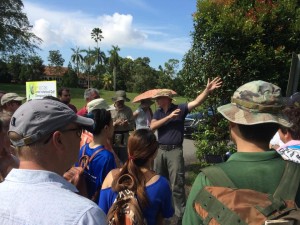
Last Battlefield Tour of 2014 by the lively and knowledgeable war archeologists Jon Cooper (photo Bianca Polak)
In 2014, we conducted more guided walks by private request. Of all the requests for guided walks, the most enthusiastic and frequent requests came from our educational institutions from secondary to tertiary institutions both local and international for “Learning Journeys”
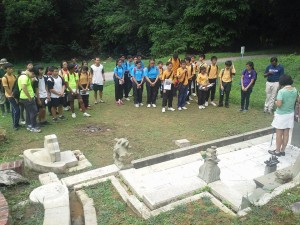
Dunman Secondary School students observing a minutes silence at the grave of Tan Ean Kiam (photo Yik Han)

JNV-Students-at-Ong-Sam-Leong-photo-All-Things-Bukit-Brown
We shifted gears from guided walks and organised on request by Standard Chartered Bank, a Corporate Social Responsibility event which was so successful, the bank has already completed 3 sessions at Bukit Brown of clearing and cleaning selected tombs between May and November 2014. They will make a comeback in 2015.
On site, discoveries continued to be made. This year alone, the two great finds were the founder of Hong San See temple Neo Jin Quee and the family cluster tombs of Lee Kuan Yew maternal ancestors.

Zaobao report on finding Neo Jin Quee, founder of Hong San See Temple, May 5, 2014
On site, as we have done, for every year since 2012, we celebrated NDP ’14 , Our Bukit Brown, Our People with both gusto and with sadness in an landscape which has changed and will continue to change as the road works encroach slowly but surely .
On site, sometime in November, while we were not looking, the ole raintree was chopped down and overnight it was gone, our consolation comes from our shared memories.
C is for Community
It has been the heart of community and your passionate support which has sustained, encouraged and uplifted the Brownies over the past 3 years. A community which includes academics, journalists, artists, writers, descendants, tomb keepers and fellow activists in heritage and the environment. We single out for our gratitude the Singapore Heritage Society and the Facebook Group Community Heritage Singapore- Bukit Brown Cemetery.
When a call was made for feedback to be given on the URA Draft Masterplan 2013 in December of the same year, we received some 30 responses which were sent to the Ministry of National Development. You wrote on how important it was to preserve Bukit Brown for future generations, for the environment, as a space important to root Singaporeans to the land and for the sharing of collective memories.
In June 2014 the Masterplan was gazetted with no changes to plans for Bukit Brown. But if you thought, your efforts were for naught, let us reassure you, it was noted and it did make a difference in paving the way for better engagement on the future of Bukit Brown. We have only just began.
In 2014, three major academic papers on Bukit Brown were published
We thank : (Drs) Natalie Pang and Liew Kai Khuin “Archiving the Wild Archivists”, Dr Terence Chong (Singapore Heritage Society) “Bukit Brown municipal cemetery: Contesting Imaginations of the Good life in Singapore” and Prof Huang Juanli ” Resurgent Spirits of Civil Society Activism: Rediscovering the Bukit Brown Cemetery in Singapore” for their comprehensive and thoughtful and thought provoking papers.
To the descendants who have trusted us with their stories, we salute you.

Gillian Lim-Mendy with her husband flew from London to pay their respects to their Grandfather Lim Hock Seng for the first time in December. Her story can be found here (photo Catherine Lim )

Brownies visit the grave of Yap Geok Song, newly renovated after descendants contacted Peter Pak to show them their ancestor’s tomb after reading his blog
And a special mention and shout out to Zaobao journalist Chia Yei Yei and the heritage reporters of Zaobao for the breathe and depth of coverage they have given to all things related to Bukit Brown from pioneers to Brownies in 2014.
The Chinese daily capped off the year in recognition of the part the Goh Brothers have played in uncovering our historical and heritage gems by headlining them among the paper’s Personalities of 2014.
We ended 2014 on site, in the last guided walk of Bukit Brown for the year with some 50 people turning up.

Collections, Recollections and Our Favourite Moments, last guided walk for 2014 on Sat, 27 Dec (photo Yeo Hong Eng)
50 is of course a significant number as we cross the threshold into 2015. 2015 is SG50, a year of national celebration of 50 years of our history and achievements. But what can we look forward to in a landscape which will continue to be pockmarked and drastically changed by construction work on the development of a highway?
We will keep calm and carry on, engage constructively, walk the ground, walk the talk, continue to be excited by new discoveries and we will – and this is a clue – write a new chapter on our past and take it into the present. In short, we will continue to honour our heritage, habitat and history, and remember those who laid down their lives in memoriam for without them, SG50 would not be possible.
“Lest we Forget”
We remember Victoria Tan and Edmon Neoh-Khoo
RIP
Compiled by Catherine Lim
All Things Bukit Brown congratulates Raymond and Charles Goh who have been chosen by Chinese news daily Zaobao to be included in their list of Personalities of 2014. For the Brownies, it is a timely recognition for the 2 brothers who have been exploring and uncovering the “lost” heritage and history of Singapore since the mid 2000s. Their hard work, sheer doggedness in research and walking the ground, is our inspiration, and we are proud to claim them as Brownies and proud, we walk with them
===============================================
Translated Article by Raymond Goh
2014 Personality of the Year by Zaobao weekly, Dec 28, 2014
Raymond Goh (51) and Charles Goh (46), Looking at history through the departed
If not for praying to one’s ancestors, one would not usually go to the cemetery. That day the reporter asked a taxi driver to drive her to Bukit Brown cemetery. The driver was not very happy, and so she has to alight at approx. 200 metres from the cemetery at the road cross junction. But the Goh brothers does not have any sort of taboo. They keep on bringing people to the cemetery to look for their roots, rediscovering old tombs hidden in the depths of the forest, bringing history back to life.
Ever since Sep 2011 when news broke out that part of Bukit Brown has to give way to a road and approx 5000 tombs has to be exhumed, nearly twice a month during weekends and public holidays, one would see volunteer guides from all walks of life known as “Brownies” wearing Bukit Brown heritage T shirts, and guiding the public on the history and heritage of Bukit Brown.
Raymond and Charles Goh are a familiar pair among the Brownies and the pioneering guides among them.
Bukit Brown Pioneering Explorers
Charles Goh is a construction safety manager and has from young like to explore the unknown to get to the root of matters. Some things will be forgotten or disappear as one grow up, and Charles hope to revive the forgotten collective memories. Since the SARS crisis of 2003, Charles responded to the call of STB and together with his brother registered as tourist guides. They do voluntary guiding for visitors to the cemetery, and let these visitors know Singapore in an unique way.
Together with Raymond Goh, a pharmacist, they founded Asia Paranormal Investigators, as a step forward to fulfil their ambition to research all things unknown. Since 2006 they also started to lead tours to Bukit Brown, do research into tombs and even design a cemetery map for the public to do DIY tours on their own.
Raymond said that Bukit Brown and the surrounding Seh Ong and Hokkien cemeteries has a total of 200,000 tombs, with the earliest dating all the way to 1826. From that year to the closure of the cemeteries in the early 1970s, one can see 150 years of changes and transformations reflected through the tombstones of Bukit Brown. Our history is gathered piece by piece from the collective stories of all these tombstones.
2014 Great Finds
Through the efforts of Charles, Raymond and the Brownies, there has been a surge in interest to find one’s ancestor. Due to the passage of time and insufficient information, the success rate of finding one’s ancestor for these tombs is only about 50%, but the rediscoveries of pioneers’ tombs provide much encouragement to the Goh Brothers. This year alone, the two great finds are the founder of Hong San See temple Neo Jin Quee and the family cluster tombs of Lee Kuan Yew maternal ancestors.
According to the archives, Hong San See founder Neo Jin Quee was relocated to Bukit Brown cemetery. When Raymond Goh first encountered this tomb, he combined forces with local history researchers Walter Lim and Ang Yik Han to research into this tomb and finally confirmed the identity of this tomb. The discovery of Neo Jin Quee’s tomb and the tombs of his wife, son and daughter-in-law provide important clues to the study of the immigrant stories of early Lam Ann people to Singapore.
Apart from this, in Jun this year, a news report to find the rickshaw puller Koh Teong Koo made Raymond recalled about Lee Kuan Yew maternal grandfather Chua Kim Teng and maternal grandmother Leong Ah Soon. Based on the clue provided by tombkeeper Soh Ah Beng, Raymond and Walter Lim finally found the tombs of Chua Kim Teng, his second wife and his father’ tombs. They later managed to find Leong Ah Soon’s tomb from the burial register, that is Chua Kim Teng’s third wife. The Chuas were a typical Peranakan family, and Chua Kim Teng was a successful merchant. These finds provide important historical information for the study of this early Chua pioneer family.
Apart from graves, Charles Goh is also interested into heritage sites and ruins. Not long ago, together with NHB Group Director (Policy) Alvin Tan, they rediscovered a century old lunatic asylum wall, which provide valuable information for the study of this early institution.
The greatest difficulty in finding graves is not mosquitos and insects bites, nor wild snakes or animals, nor wild vegetation, but the limited information and resources to find the graves.
Although there are burial records in Bukit Brown, many descendants does not know the dates their ancestors passed away, and some can only remember their ancestors’ Chinese names, while the records are in English. The lesser the information, the more difficult will be the tomb find.
As such, Raymond said that sometimes it require more than the efforts of one or two persons, but the combined efforts and expertise of many volunteers to help find a tomb.
As for 2015, the Goh brothers will keep on their volunteer work of researching and finding tombs, and their mission is to find an earlier tomb than 1826 as there were already Chinese people then who died before that.
By Mok Mei Ngan
Catch a video of Raymond Goh on zaobao.com, sharing his interesting discovery of Bukit Brown Cemetery here
================================================
Zaobao weekly – 2014 Personality of the Year
They may not be famous people in the limelight,
But yet each in their chosen field give out their own light and heat and leave behind beautiful imprints in 2014
There is a Western proverb “The devil is in the details”, which means that it is in the details which spell success
These six personalities selected by Zaobao Now are chosen especially for their insightful analysis and acute observation, taking care of the whole situation, yet not leaving out the smallest details to ensure success for their endeavours
They are :
Two relatively unknown “amateur archaeologists” brothers Raymond Goh and Charles Goh who started to find old tombs to return back history. In this rapidly growing city of ours, they search for old tombs and uncover lost history. They also bring people to cemeteries to search for their roots and let the light shine once more upon the hidden tombs in the forest, bringing history back to life
Artist Ong Keng Seng who revamped the Singapore International Festival of Arts to reach out to a wider audience. His 12 chosen productions attracted widespread discussion
Chef Julien Royer from Swissotel Stamford Jaan restaurant for his passon in the culinary arts and for winning multiple culinary awards, and let foreigners look at Singapore food scene
Photographer Sim Chi Yin. Originally an ST correspondent based in Bejing, she give up journalism for photography, and use her passion for the lens to reflect Chinese mainstream society in China. In July this year She became the only Asian photographer to join the Internationally renowned VII Photo Agency. In Oct she was selected by Her World magazine as this year Young Woman Achiever
Christopher Lee Meng Soon for beig the first non-Taiwanese to win the Best Actor Award in the 49th Golden Bell Awards. His win means that the top awards coming from Taiwan for the Cinema, Music and TV all have been won by our local artistes, and mean that here we do have internationally recognized acting talents.
JJ Lin for winning the 25th Golden Melody Awards for best mandarin male singer. He also won two awards from the 19th annual Composers and Authors Society of Singapore (COMPASS) for top local artiste for the 6th consecutive time and best song writer for the 4th time
by Sally T.
One recent Saturday, some friends and I had the pleasure of being guided around Bukit Brown Cemetery on a special tour led by three descendants of notable people buried there. The Descendants Tour was presented in partnership with the National Library of Singapore – a great community initiative on the part of the library. A few seasoned guides helped lead the group, which really helped to add insight and context along the way.

Claire, a Bukit Brown volunteer guide gave a brief introduction on the history of Bukit Brown Cemetery and Singapore’s pioneers (photo by Simone)
Each of the three descendants had fascinating stories to share and we were treated to what I would describe as a once-in-a-lifetime experience. Hearing them so passionately and proudly tell familial histories and sing songs in honour of their ancestors, many of whom were pioneers of early modern Singapore, will be something I look back on as a highlight of my time living here. We visited the resting places of enterprising business people, diplomats and philanthropists – the type who have streets named in their honour.
In recent years I had heard a lot about Bukit Brown, a national treasure that had been rediscovered by a caring community and was being hard fought for. Despite my curiosity I’d never visited, perhaps not wanting to feel inappropriate or as an invasive foreigner, but a conversation with a friend who is a passionate historian prompted me to look up the next tour available. The fact that three descendants were taking the tour alongside a few experienced Brownies seemed like a unique opportunity and one not to be missed. I was right.
Our meeting point was just near the LTA temporary set-up, which we figured was the site headquarters for the current exhumation works taking place in certain sections of Bukit Brown. There’s no denying that it’s a confronting reality. While I’ve known for a while that exhumation is fairly common here, I learned that it has a relatively long history in Singapore and happened under British rule too, as one of the graves we visited had actually been moved there from somewhere else in the 1930s or 40s. The current works were well underway when we visited, with high fences erected throughout. From the main road, you would easily have mistaken it for any construction site.
Once the large group of about 30 was assembled, we walked a short distance to the tomb of Chia Hood Theam, who was a respected businessman with a lovely black and white home called Rosedale at the corner of Devonshire and Killiney Roads. Chia’s maternal great-great granddaughter Noreen Chan, along with some other family members present, shared a series of beautifully preserved photographs and stories that had been passed down through the generations. Noreen described how as well as being a ‘comprador’ – the business relationship managers of the old banking regime – her Peranakan grandfather was an early champion of women’s education in Singapore. The tomb was well preserved and had beautiful tiling work.
Next stop was the tomb of one of Dr Lim Su Min’s several ancestors buried at Bukit Brown. On this mother’s side, Dr Lim’s lineage can be traced back to Tan Tock Seng, a prominent merchant and philanthropist who of course the hospital is named after. We visited the tomb of a relation of Tan Tock Seng. An impressive tomb turned a rusty orange from the lichen, the resting place was a little way up a small hill. After sharing his fascinating family history, Dr Lim treated us to an intimate and special moment as he sang a song he had written in his ancestors’ honour. Standing there with only jungle noises to compete with the ukulele, we knew we were witnessing something heartfelt.
The third tomb we visited was tucked much further into the jungle, and on the way we passed some extraordinary tombs, all with different style and character. Clearly, grieving family members had gone to a great deal of trouble to put their loved ones to rest in a place of beauty. The third descendant to share with the group, Serene Tan, went on a mission to find her family’s cluster of tombs after being visited by a man in Mandarin robes in her dreams who encouraged her to visit. After a long search and some coincidences that could only have been fate, one of the Brownies came across the tomb of Serene Tan’s ancestors, including Tan Quee Lan, which were in somewhat of a rundown state. Together with family members, the Tans have done an magnificent job of restoring the tombs with an impressive marble structure.
Dr Lim Su Min once again led us to the last tomb of the tour, which belongs to the eldest son of Tan Tock Seng called Tan Kim Ching, who was successful in further expanding the family’s business empire with rice mills and tin-mining in Siam. The size and stature of the tomb was very impressive and Tan Kim Ching was clearly an important man. After gaining the trust and respect of the King of Siam, Tan Kim Ching was appointed a Singapore-based diplomatic representative of the court of Siam. We learned that he also represented Japan and Russia in diplomatic relations in Singapore. One of the most intriguing things I learned was that Tan Kim Ching was responsible for the posting of British governess Ann Leonowens to Siam to famously teach the children of the King.
I found Bukit Brown majestic in both the grandeur of the tombs and the beauty of nature which has enclosed or almost seemingly protected the site in its forgotten years. When one of my friends who came along mentioned that he was visiting Bukit Brown to some Singaporean business associates, he was met with wide eyes and trepidation! While I wouldn’t want to go there at night, it wasn’t as eerie as I suspected so I would strongly encourage those with an interest in Singapore’s history and culture, and strong sense of family values, to visit this special place. My friends and I will pass the word on about the tour to our friends – foreigners and locals alike – in the hope that more people will come and experience Bukit Brown. Who knows whether they will find an ancestor of their own.
______________________________________________________________________
The Descendants’ Stories – A Guided Walk at Bukit Brown (English)
Saturday, 8 November 2014, 4 pm – 6.30pm.
All Things Bukit Brown* is pleased to curate a guided walk in conjunction with the roving exhibition “Bukit Brown: Documenting New Horizons of Knowledge”
Registration is required and all queries is through the NLB website here , spaces are limited to 28.
About the Walk:
News that a highway was to be built across Bukit Brown in 2011 led some descendants who had lost touch with their ancestral tombs to embark on a quest to find them. Some of those who were successful shared their stories of reconnecting with their ancestors and family oral history with the volunteers on the ground, called Brownies.
For this special walk, 3 descendants of prominent figures in business, philanthropy and diplomacy in the 19th and 20th centuries will be sharing their stories first-hand at the tombs of their ancestors.
- Dr. Lim Su Min’s maternal lineage can be traced back to Tan Tock Seng, whose eldest son Tan Kim Ching grew the family’s fortunes, expanding into Siam with rice mills and tin-mining. He became a confidante of the King of Siam, and was appointed a diplomatic representative of the court of Siam. (He held similar positions representing Japan and Russia.) Among the stories Dr. Lim will share at Tan Kim Ching’s tomb is his introduction of a young English widow, Anna Leonowens to the Siamese King, a story which became immortalized in an Oscar winning musical.
- For Serene Tan, the journey of discovering her family’s cluster of tombs at Bukit Brown started the night a man in traditional Mandarin robes came into her dream and passed her a note that simply said “Why no one visit?”. Serene will share how she was finally able to find the tombs of Tan Quee Lan of whom she is a direct descendant on her paternal side after a few years and in the process connected with a long lost cousin. Both then went on to restore and refurbish the family cluster of tombs at Bukit Brown, which had for so long been forgotten.
- Noreen Chan comes from a long line of influential and wealthy “compradors” – the business relationship managers of the old banking regime. At the tomb of Chia Hood Theam, Noreen will recount stories of her maternal great-great grandfather’s frugality and contributions to women’s education from family oral traditions and historical records
**********************************************************************
Please read if you are attending our guided walks for the first time, useful info on safety : Getting There/游览信息
*All Things Bukit Brown is the banner for a community of volunteers called “Brownies” who conduct regular weekend guided walks and do independent research on the heritage, habitat and history of Bukit Brown. They have guided over 13,000 people since they started their guided walks at the beginning of 2012.
The Story Behind Peg 2906
by Norman Cho
How many of us believe in the unexplained? There are reasons why certain things happen unexpectedly. But are we receptive enough to take the cue from such signs? One recent account was of tomb 481 which was pegged 2906 at Bukit Brown Cemetery, slated for exhumation to make way for the 8 lane highway due to slice the cemetery in half by 2017/
A post about the Ee Hoe Hean Club in the Facebook page of Heritage Singapore – Bukit Brown Cemetery, spurred me to do a search on my granduncle, Mr Tan Kay Tiang (ie) the husband of my paternal grandmother’s second sister, Mdm Yeo Say Neo. Grandmother had once told me that he worked for an exclusive millionaires’ club called the Ee Hoe Hean Club. No details of the position which he held or the period where he was under their employment were given.
Out of curiosity, I did a Google search over the internet and found to my astonishment that he was buried in Bukit Brown Cemetery and that his tomb was marked for exhumation with the peg number 2906.
I made a few enquiries and discovered that the tomb had yet to be claimed and that it was due for exhumation in only three weeks! I tried to contact the deceased’s three grandchildren unsuccessfully to make a claim. They are in their fifties and sixties and I sensed their reluctance. They probably have their reasons to decide not to do anything about it.
Looking back, I realised that discovering his tomb just three weeks before the exhumation was no mere coincidence! Possibly, he was trying to reach out to someone to handle his exhumation and to relocate him during the desperate final few weeks. I felt very uncomfortable if I did nothing about it and so I decided to claim the tomb on behalf of the family. To make sure that I had identified the correct tomb, I verified the name of his only child on the headstone – 月娘which corresponded with the name of my late aunt, Guek (Guat) Neo. I found a newspaper article in the online digital archive (Newspapersg) which confirmed the identity of the tomb.
Family accounts has it that he died due to septic wound on his foot caused by a nail which he accidentally stepped on. He had concealed nails on the ground along the exterior wall of his house at Neil Road to deter thieves. The irony was not lost on me that these nails were what caused his death, A newspaper report in The Straits Times, 19 June 1938, “Nail Causes Man’s Death” returned a verdict of misadventure. The date of death on the tomb was 10 June 1938.
Tan Kay Tiang married my grandaunt, Yeo Say Neo, in 1923 at his family home in Neil Road. He was 39 and she was 27. During those days when people commonly married in their teens, they were considered an old couple. The couple stayed together with Kay Tiang’s widowed elder sister and his mother.
My grandmother recalled visiting the 3-storey townhouse and was intrigued by the many carpets that she saw on each floor. The couple had their first and only child, a daughter, Guek Neo, in 1925. He was a doting father who was known to piggy-back his daughter till she was nine or ten. The maid would take over after he was tired. As a child, my aunt was thoroughly spoilt and there was an account where the maid was made to walk the dark alley to buy her favorite char siew pau for her supper.
After her father’s death when she was twelve, Guek Neo’s life took a drastic change. She had become a sensible young lady. The house was sold several years later and Guek Neo was arranged to be married to a Baba named Robert Chia, the son of a well-known nyonya medium in the 1920s and 30s who was known by the name “Ah Lian Potong Lemo” She could predict fortunes by reading the sliced limes.
Mrs Tan Kay Tiang (Yeo Say Neo) was the ideal wife and homemaker. She excelled in cooking and sewing. She was soft-spoken and mild-tempered. She did not gamble and hardly stepped out of the house. The maid would run all the family errands and do the marketing. To supplement her living expenses after the death of her husband, she made nyonya kueh which her maid would take to the coffee shop at Joo Chiat Road to sell. She eventually had to let her maid go as she could no longer afford to keep her but the maid was reluctant to leave her and stayed on for a few more years.
***
A footnote:
Every tomb is a repository of personal stories of the family that was left behind
Moving forward 76 years later, I had made a claim for the tomb to be exhumed on 14 July 2014 and the remains to be re interred at Block E0116-202 in Choa Chu Kang Columbarium. It would be easier for me to visit since most of my relatives are placed there. He was buried in the traditional Chinese coffin which was relatively intact and had several funeral artifacts which included miniature clay kitchen utensils and two pieces of circular glass which I suspect could be reading glasses – one concave and the other bi-convex.
About Norman Cho:
Norman Cho is a regular contributor to atBB and guest blogs about his search for his roots and Penanakan material culture. He is the founder of the facebook group Peranakan Material Culture
You can find out more about Norman’s search for his roots here and here and posts about Peranakan culture here and here.
Singapore is 49 and Bukit Brown is 92! The invitation went out weeks before on the blog, on Facebook, the event of the year at Bukit Brown, celebrating the nation’s birthday. Thank you to all who came, regulars, first timers, old and young, singers and well wishers. The official NDP’14 theme was a good fit :
NDP ’14 (Nations Deceased Pioneers) @ Bukit Brown this year honours the “can do” and caring spirit of our pioneers who helped to forge bonds which built the foundations for SG 50. It is the story of how “Our People” in Bukit Brown made Singapore, “Our Home”.
We promised 3 guided walks, goody bags, eats and music. But the highlight as always is the singing of the National Anthem – this year led by Brownie Mil Phuah, the reciting of the Pledge – this being Raymond Goh’s first ever NDP@Bukit Brown (previous years he was away on business trips) it fell on his shoulders, followed by a minutes silence to remember especially the 4,153 pioneers who have had to make way for the highway. Our resident videographer James Tann captured an NDP on the celebratory Hill 1 festooned by flags large and small, and the pride of over 50 voices.
It has been a momentous past year for Bukit Brown from being on the World Monuments Fund watchlist to be being voted by Singaporeans as their top 3 sacred sites . The good news continued as Claire Leow, co founder of All Things Bukit Brown, shared some more developments .
“We are humbled and honoured to announce that thanks to the nomination by the Singapore Heritage Society, all things Bukit Brown has been shortlisted for the inaugural Singapore Advocacy Awards 2014, under the category of Civil Society Advocate Organisation of the Year.
The winner will be announced Aug 30, but let us say now for the record, just being nominated has been a real honour as a recognition of all that this community has achieved since early 2012.
To date, the Brownies have guided more than 12,000 people, staged two exhibitions, and tried to connect descendents, academics, students and teachers, docents, heritage bodies and communities. We don’t always succeed but we surely give everything a passionate shot! Your unstinting support as a community has sustained us. We have guided rain or shine or exhumations. Behind the scenes, many work hard to raise awareness of the intrinsic value of this historic site, and a few have worked patiently with the authorities for a better outcome.
We thank all of you for your support in our endeavour. It is an understatement to say it has not been an easy mission. But driven by conviction, we have carried the heart of this community. We have become good friends, and made good friends. Inspired by the early groundwork laid by Raymond Goh and Charles Goh, the Brownies have built on a solid foundation to spread the word: this is our heritage, habitat and history – and we appeal to you to join us, and honour our pioneers and save this sacred site.
On this, the 49th birthday of Singapore, we say, Majullah!” Claire Leow, Co Founder, All Things Bukit Brown.
***
Bukit Brown was also highlighted in the national daily Today August 9th Special issue Preserving Memories of a Changing Nation
“In 2012, the two women created a blog, all things Bukit Brown, to provide a platform for people to share memories of the area as well as to raise awareness of the walks they were planning there. Since then, the blog has garnered more than 550,000 views and more than 4,000 members on its Facebook page.
With the help of 40 volunteers called Brownies, the two women have also guided more than 11,000 (now 12,oo0)people on their Bukit Brown heritage trails.
“This shows we made the right move and have won the hearts and minds of the public,” said Ms Lim, now a freelancer in broadcast media. She attributed the positive response to the blog and heritage trails to more than just nostalgia. “It’s a much deeper meaning — a yearning, post- sickness, when old places have to move for new ones.”
Since 2012, all things Bukit Brown has also added a unique twist to the National Day celebrations: While others get ready for the National Day Parade, its members have their own National Deceased Parade. This year, they plan to go on a heritage trail in Bukit Brown to commemorate Singapore’s pioneers for their resilience, contributions to and sacrifices for the country.”
****
Here are highlights from the different heritage trails, behind the scenes set up and the camaraderie and conviviality that took the celebrations from dusk to moonlit night. Thank you to all who came, regulars, first timers, old and young, singers, photographers and well wishers. the Brownies are grateful for your support. Here are your memories:
The Guided Walks by Claire, Bianca, Fabian, Simone and Walter
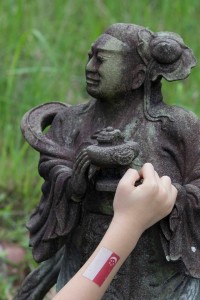
埋骨何須 故里 盖棺 便是吾盧 Why is it necessary to bury my bones in my ancestral land? The place where my coffin is sealed is my home Tan Ean Kiam, on his tomb at Bukit Brown(photo Philip Holden)

The Chinese Tour led by Walter Lim, had some Hongkong visitors, so Cantonese was also the lingua franca of the day (photo Victor Yue)
Behind the Scenes, A Team of Brownies Setting the Stage for Celebration
Celebrations!
National Anthem as recorded by Albert Ong
Not Just Singapore’s birthday but 3 Brownie Birthdays in August!

Left to right “Uncle Foo aka Garden Hill” 9 August, Simone Lee 10 August and Keng Kiat 11 August- HUAT AH! (photo Khoo Ee Hoon)
” Deeply reflective and moving National Day observance at Bukit Brown today, with graves already exhumed and half the site sectioned off for the road. There are some things that money can’t buy. A big thank you to Catherine Lim, Claire Leow and others!” Philip Holden.
A big shout out to those behind the scenes and catering:Brownies Victor Lim, Sugen, Mil Jonathan, Raymond, Ee Hoon, Peter, Steven, Mitch, Andrew and tombkeeper Lim Ah Chye. To Lee Kok of Asia Pac Publishers for contributing goodies to goody bags, National Heritage Board for the bags and National Library Board for commemorative books on Khoo Seok Wan.
Preamble : Hungry Ghost Festival
Saturday, 26th July was the eve of what is popularly known as the Hungry Ghost Festival, and less well known by its traditional name of Zhongyuan Jie, which in essence is also about honouring ancestors. It takes place at the start of the Chinese 7th lunar month, and it is when the gates of hell open and the spirits of dead are free to wander among the living for a month. To appease them, offerings and entertainment is laid out by descendants at their homes, but also by temples, business and clan associations. This year, the prediction was that hell’s gates will open at 11pm on the eve of the festival.
The Salvation Rituals
At Bukit Brown, devotees from the Taoist temple Xuan Jiang Dian (Heng Kang Tian ) conducted a “chao du” or “salvation rituals” – considered an act of compassion – specifically for the forgotten and lost spirits there.
This is the 3rd year in a row, Xuan Jiang Dian have done this, ever since in fact news of the building of the highway across Bukit Brown in 2011 was announced. Exhumations of the some 4.153 graves which are in the way of the highway are drawing to a close. So there was added interest in this year’s ritual which was covered by our national newspapers. The National Heritage Board (NHB) shared that a specially commissioned video on rites and rituals at Bukit Brown will be uploaded soon to you tube.
A First Hand Account of “chao du”
The ” chao du” ceremony which was witnessed also by Brownies and other well wishers, started at around 8.3opm . It consisted of the setting up of an altar table with offerings at the major junction of the 4 roads in Bukit Brown which leads to Blocks 1, 5, 4 and 3.
The Taoist priests from China, resplendent in their robes, chanted and walked several ceremonial rounds in the area calling upon lost spirits. There was something soothing in their chanting and the air was redolent with the scent of what must have been a hundred lighted joss sticks. Each participant carried 3 sticks each throughout the 40 minute long chanting.
There was a stillness in the air and the smoke and swish of the robes carried the movement of the night. It ended with the burning of paper offerings and just as quickly as it was set up, the devotees packed up and left, with the the candles planted still burning and the last vestiges of the paper offerings smouldering down to embers.
******
Photo Gallery :

Side View : Off site 3 tablets, set up by Xuan Jiang Dian at Bukit Merah Blk 123 for the wandering spirits of Kopi Sua aka Bukit Brown. [right] for animals killed during agricultural activity (prior to it becoming a cemetery)[centre] for wandering souls[left] for animals killed during construction works (photo and caption by Chua Ai Lin)

Front View : Off site 3 tablets, set up by Xuan Jiang Dian at Bukit Merah Blk 123 for the wandering spirits of Kopi Sua aka Bukit Brown. [right] for animals killed during agricultural activity (prior to it becoming a cemetery)[centre] for wandering souls [left] for animals killed during construction works (photo Raymond Goh)
Report on Lianhe Zaobao on a ritual conducted last night at Bt. Brown which marked the opening of the 7th month: A group from Heng Kang Tian including 8 Taoist priests conducted the ritual to invite spirits to a salvation ceremony conducted today in front of Bukit Merah View Block 123. The group has been going to Bt. Brown for the past two years to invite spirits from tombs which are not tended to by descendants. The event was attended by Brownies and participants of tours at the cemetery. It was also recorded by the Bt Brown Documentation Team. NHB is currently preparing a 10-15 min documentary on the rituals carried out at Bt Brown cemetery. This will be uploaded to the NHB channel on youtube, “yesterdaysg”, around end next month. (summary by Ang Yik Han) Full report in Chinese:
文物局到武吉布朗坟场 记录“招魂”仪式
王舒杨
联合早报2014年07月27日
今天是农历七月初一,华人传统节日“鬼节”今起开始。昨晚,武吉布朗坟场文史记录小组和国家文物局人员特地到武吉布朗坟场,记录一场由道教团体进行的祭祀仪式。
昨晚约9时,应道教宗教团体玄江殿邀请的八名道长和一名唢呐乐师在武吉布朗坟场进行“招魂”仪式。在道路两侧点亮“引魂”的香火后,他们在锣鼓声中唱诵经文。今明两天他们将在红山景第123座前的道场举行大型超度法会。
数十名积极参与保护武吉布朗文化遗产的公民团体成员也到场目睹仪式。除了这些“武吉布朗人”,不少报名参加坟场导览活动的外国人和游客也纷纷拿起相机拍下这个独具特色的活动。
玄江殿自1996年起多次在武吉布朗坟场举行农历十月初一的“寒衣节”祭祀活动,并从两年前开始在武吉布朗坟场举行七月鬼节的法事,目的是在坟场进行招魂,为他们超度。
根据武吉布朗坟场文史记录小组整理的资料,武吉布朗坟场里的中元节如同一项社区活动,是一种灵界上的慈善事业。信徒所祭祀的亡魂通常与他们没有任何亲属关系,尤其是孤魂。
玄江殿主持陈荣兴(45岁)说,武吉布朗一些坟墓主人没有子孙祭拜,所以希望能为这些孤魂超度。
此外,道家也相信所有生灵皆可超度,而坟墓挖掘过程中伤到蚂蚁等生灵,超度法事也怀有对它们的尊重。
国家文物局目前正在筹备一个10至15分钟长的纪录片,介绍华人社群在武吉布朗坟场的仪式,包括七月鬼节、清明节以及较少人知道的寒衣节。短片料下月底上载到文物局的YouTube频道“yesterdaysg”。
文物局总司长(政策)陈子宇说:“武吉布朗坟场不仅仅是一个埋葬地点,也是华人社群进行祭祖等仪式的地方。我们会记录这些仪式,以继续丰富我们有关新加坡非物质文化遗产的数据库。”
公众可通过在国家图书馆大厦9楼展出的“武吉布朗:记录新知识 开拓新视野”中英文展览,了解武吉布朗坟场上世纪的演变、坟墓设计和民间风俗等。图书馆大厦展览在10月10日结束后,将陆续在宏茂桥、裕廊、蔡厝港和大巴窑图书馆展出至明年1月底。
Romancing Taiping (Part 1)
A photo essay by Simone Lee
“I was a little apprehensive at the beginning. Even as a Malaysian, I’ve never heard of anyone raving about a visit to Taiping. But while we were there, I fell in love…………” Simone Lee (Brownie*)
Taiping History (in brief)
Plagued by fierce feuds ( The Larut Wars) between 2 prominent Chinese secret societies(Ghee Hin and Hai San, this once flourishing town in Perak, which prospered from tin mining was said to have been named Taiping – 太 (tai – ‘great’) and 平 (ping – ‘peace’) – after a truce was brokered in the Pangkor Treaty. The treaty was the result of a politically motivated call for British intervention aided by a friend from Singapore, Tan Kim Ching (son of Tan Tock Seng).
Day 1: Taiping Town and Kuala Sepetang
At the sleepy town, we met our guide, Ah Kew (Lee Eng Kew), a freelance writer and field historian. Our first stop: The Old House Museum. One of the earliest 3-storey shophouses built in Taiping, the museum/antique shop retains much of its original architecture.
(please click on images for full size photos and captions)

Our very knowledgeable and generous guide Ah Kew (pictured on the right) , who was to share with us personal insights into Taiping’s history and cultural links (photo Simone Lee)

Clockwise from left): – 1) Much of the shophouse, including the wooden spiral stairs are retained 2) A room filled with miniature cars and dolls – 3) Posters of artists and celebrities from the 60’s and 70’s line the corridor (photos Simone Lee)
Charcoal Factory
The next stop surprised everyone. As we drove into the compound of a charcoal factory, the scene took our breath away. The smoke from the kilns filters the sun rays, reminding me of movies with scenes of a dreamy, foggy mornings by the lake, embraced by mountains.
Here, Ah Kew explained the charcoal making process which typically takes several weeks before it is ready to be marketed. In the process, a by-product “‘charcoal water” is distilled from the baking wood. It is bottled and sold as a beauty product – slightly acidic but gentle enough to be used on the skin. I tried some on my face and arms, and instantly my skin felt supple, toned and smooth! Feeling vain, I wanted to order a bottle, which was selling at just RM5, the retail outlet was closed.

(clockwise from top-left): – 1) Ah Kew explains how logs from the mangrove trees are brought to the factories by boat via the stream.2) Steam from the kiln gushes out as the wood is baked so moisture, evaporates. 3) The igloo-shaped kilns in one of the factories (photos Simone Lee)

Kuala Sepetang’s Matang Mangrove Forest is the largest mangrove forest reserve in Malaysia and was gazetted as a Permanent Forest Reserve in 1906. (photo Simone Lee)
At the mangrove forest, Ah Kew regaled us with stories of 2 notorious pirates with fearsome reputations in the post war era.
Tan Lian Lay once hid bags of rice in a mangrove forest but they were destroyed when the tide rose. After his death, he was immortalised as a deity because his spirit was giving out winning numbers in repentance for his sins. It has been said Tan Lian Lay was also a trouble maker in Singapore. When he was killed in Bagan Api in Riau, Sumatra, a well- wisher from Singapore sent gifts as a reward for slaying Tan Lian Lay’s reign of terror.
Tan Hua Siea aka Raja Laut (King of the Sea) monopolized the shellfish farms and was on Perak’s most wanted criminal list. Despite that, he eluded capture, sheltered by the locals. Even though he was always dangerously armed, he never terrorised the villagers and was revered as the Robin Hood of the coast. What happened to him remains a mystery to this day.

The idyllic village belies its checkered sometimes violent past as hideouts for pirates. (photos Simone Lee)
***
Look out for Romancing Taiping Part II next week
***
*The Brownies’ yearning to connect to history and thirst for adventure, brings them to various locations within and beyond Singapore. The objectives of these retreats are, to study the historical and cultural links to Singapore, and to strengthen kinship amongst the brownies.
(Brownies are the volunteers who conduct regular weekend guided walks and independent research on heritage, habitat and history of Bukit Brown Cemetery.)




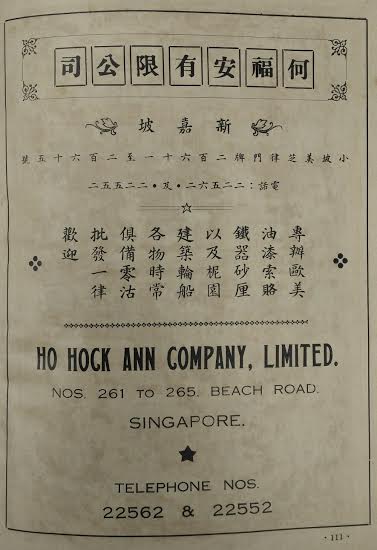











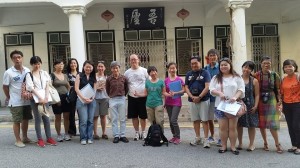



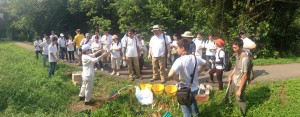






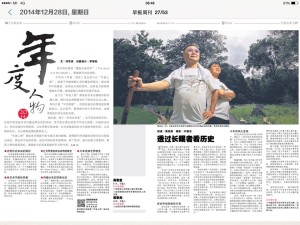





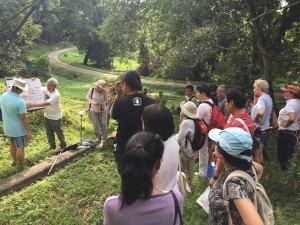


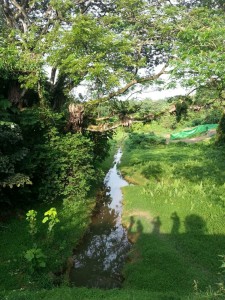





















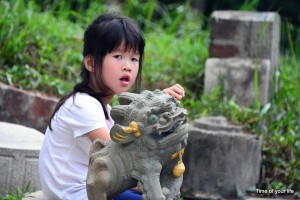

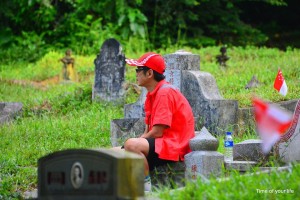


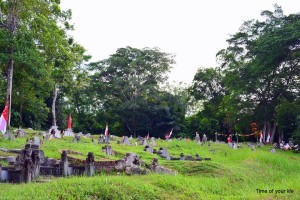













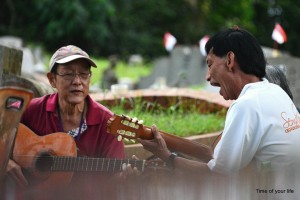

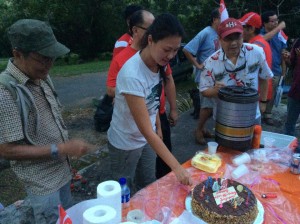












Recent Comments